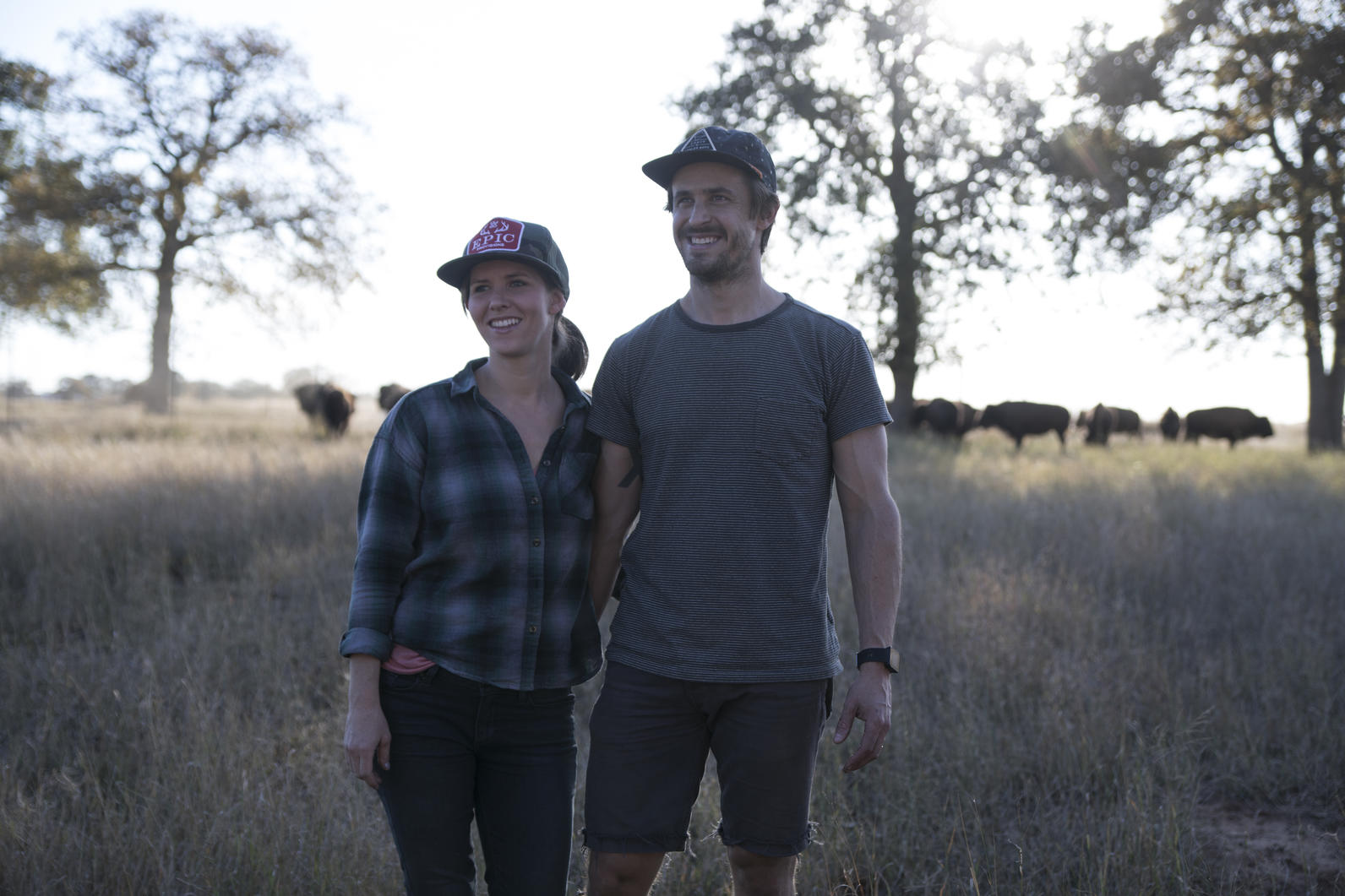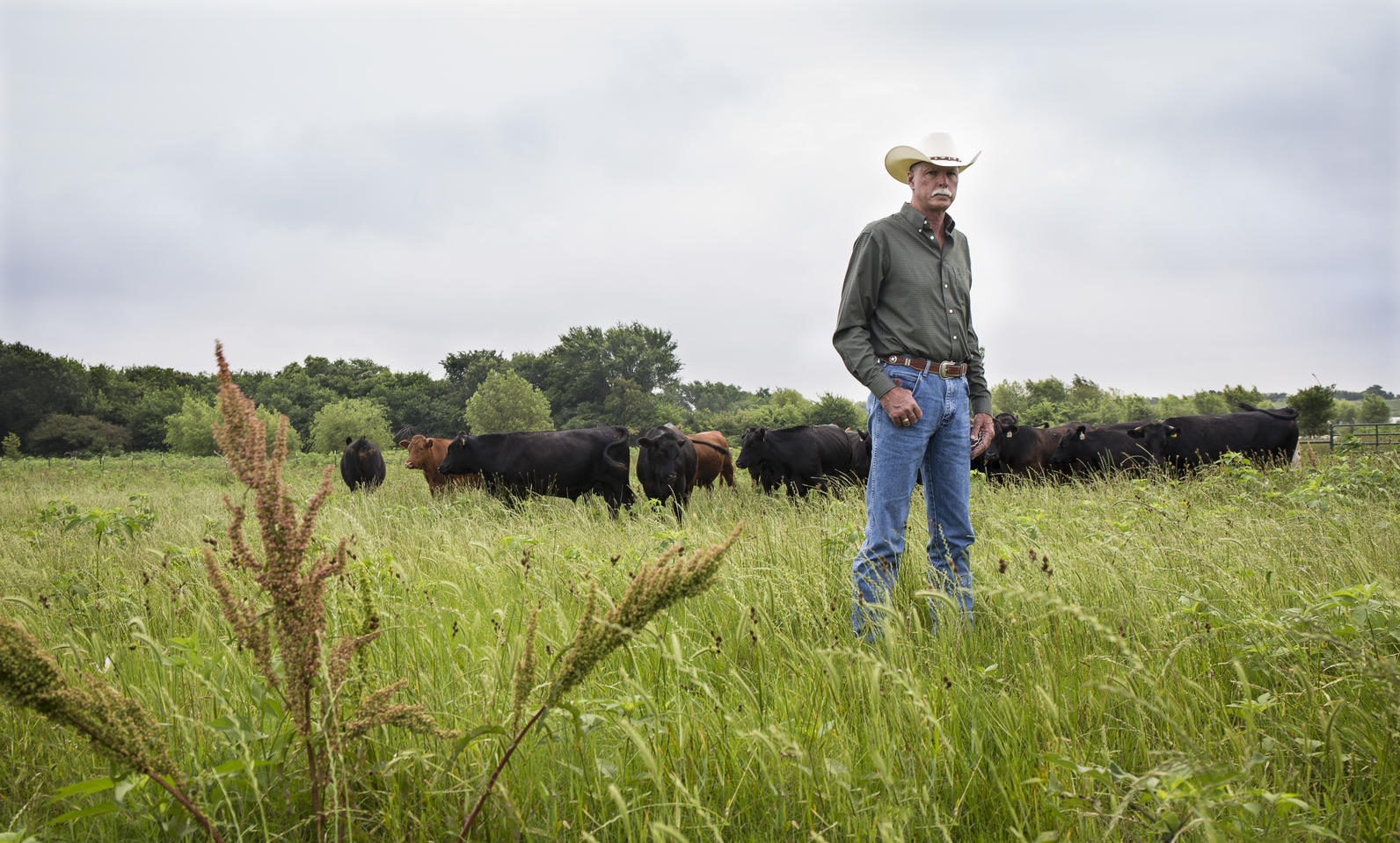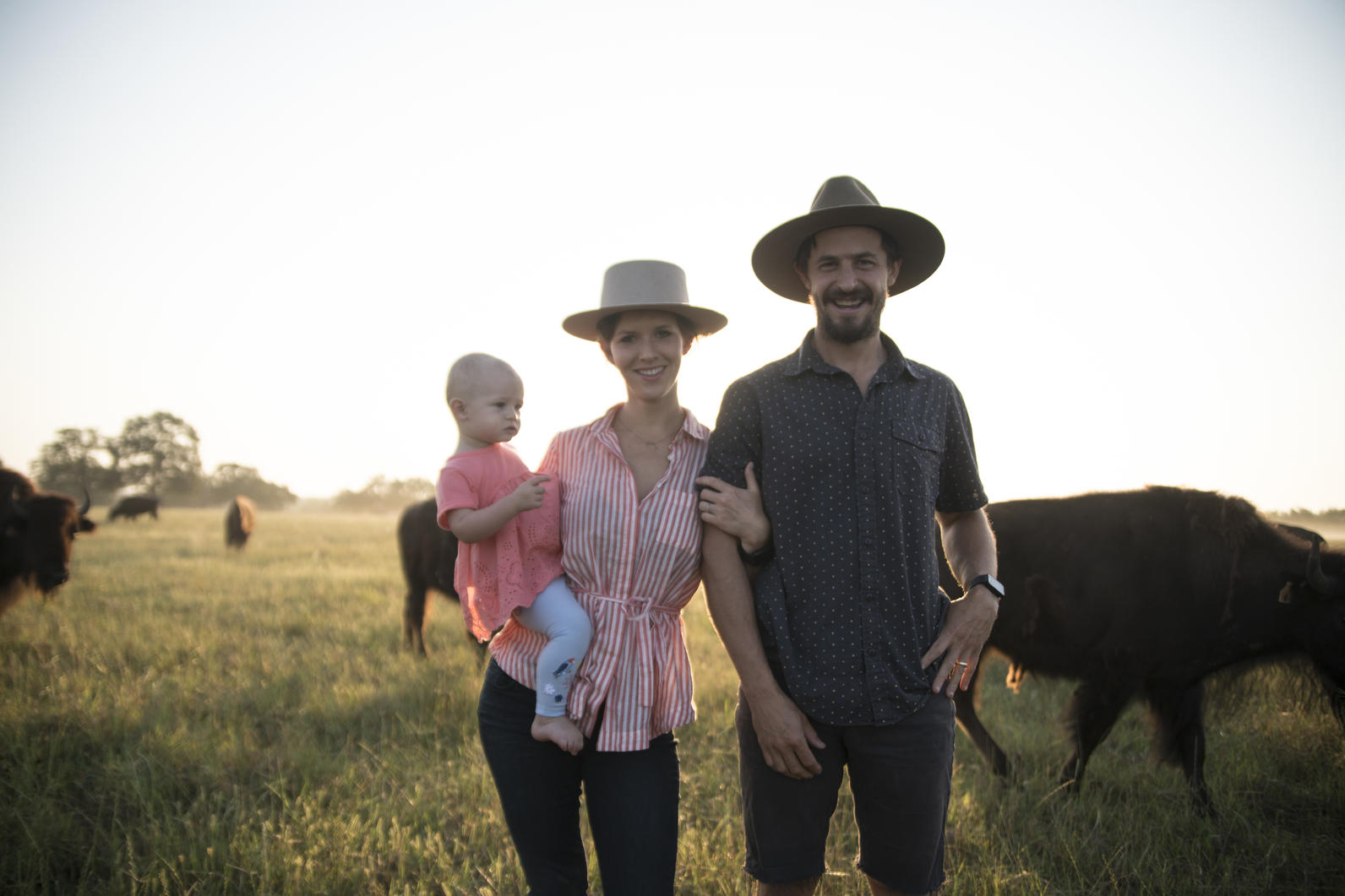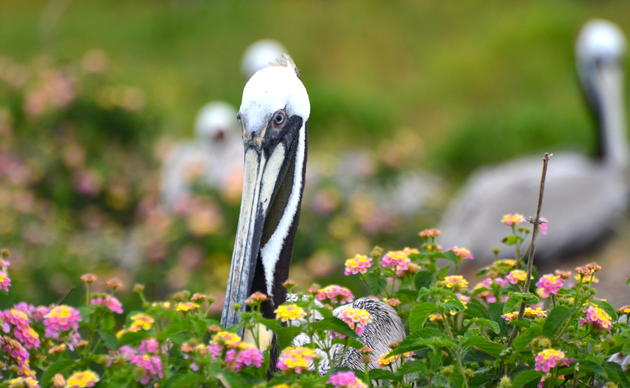Partner Spotlight: Burgundy Pasture Beef and ROAM Ranch
Native grasslands are among the most imperiled ecosystems in the world — and one of the least protected. Throughout the U.S., Mexico, and Canada, these critical ecosystems are dwindling at an alarming rate, as tracts are fragmented and degraded through unsustainable agricultural uses, proliferation of invasive plants and vegetation, encroaching human development, and poor grazing practices. As a result, many birds and other wildlife are edging closer to endangerment and even extinction.
Audubon aims to address these challenges through the conservation of focal bird species and the habitat they depend upon. We help the environment by helping birds. Since the vast majority of remaining grasslands are privately owned, we work with the farmers and ranchers that live and work on these lands. The Audubon Conservation Ranching Initiative is an innovative, market-based approach that connects conservation-conscious consumers to farmers and ranchers that employ bird-friendly management practices in raising their livestock.
Audubon currently counts 15 participating ranches in Texas, spanning 178,000 acres of grasslands across the state. Fully certified ranches include: the Dixon Water Foundation’s Mimms Unit Ranch in Marfa, Bandera Grasslands in Hondo, C7 Ranch/Burgundy Beef in Grandview, the North Mason Unit in Mason, and ROAM Ranch in Fredericksburg.
Today we are speaking with three of our ACR producers, Jon Taggart of Burgundy Pasture Beef and Taylor Collins and Katie Forrest of ROAM Ranch. We’ll feature additional ACR producers in future conversations, such as Debbie and Don Davis of Bandera Grasslands and Chad Lemke of the North Mason Unit.
Editor’s Note: This interview has been edited for length and clarity.
To get us started, can you just give us a little background on you, your operation and how you got started on the path to Conservation Ranching?
Jon Taggart: About 1999 is when we started the grass-fed beef operation. The ranch that we are on, we got there in 1995, and 900 of the 1,400 acres was plowed and they were actively farming. We started almost the very next year converting back to grass. That was about a 10-year process to get all of the farmland back to native grasses.
Like I said, we sold our first beef in ’99, and we built the processing plant in 2004. Up until that time, and a long time after that, we distributed our meat by home delivery in the Dallas/Fort Worth Metroplex. We home delivered for 17 years. We opened our first retail store in Fort Worth in 2014 and then the Dallas store was a year after that.
We started online sales way back. That went hand in hand with our home delivery, and we are where we are today, which is a different place than we were eight weeks ago.
Taylor Collins: Katie and I are first generation ranchers so we didn’t have any previous access to agricultural land, even recreational land. We grew up in the city. Getting us to this, it was based on nutrition, health, and wellness and making a profound connection between the health of the land, the health of the soil and the foods that we eat that were grown on those lands.
For us, it was the discovery of regenerative agriculture and soil health. Very early on we found a lot in the work of Allan Savory to lead us into this movement and becoming a part of it. Being out on ranches that had been doing holistically managed grazing with a focus on regeneration and soil health management for years and years was life changing. That was where Katie and I thought that these guys had it figured out as far as how they are spending their time, how they are giving back to the planet, how they are giving back to their communities.
The Audubon Conservation Ranching Initiative has ranches across the Great Plains. How would you describe what Conservation Ranching looks like on your operation?
Taggart: The biggest thing was converting the farmland back to grass. There were several reasons we did that: one, we found that farming is not very profitable. Along the way we learned a lot of lessons and the biggest one was biodiversity … I’m not going to say our inputs are at zero but they are very minimal because native grass takes care of itself. We don’t have to fertilize, we don’t spray for weeds, just very minimal inputs.
We institute high intensity, short duration grazing. We have maintained a good stocking rate and a good stock density over the years to really increase and enhance the biodiversity. Mother Nature takes over and we have seen all those native grasses flourish and the pollinators came in. When I got there we had no deer, we had no turkey; now, we probably have too many deer. It’s covered up with wildlife.
Collins: So we are in a fairly brittle environment where we have to be really thoughtful about capturing moisture and rainfall and doing that effectively in order to be successful. For us in Central Texas, it is a different vantage point of, like, how do you work with Mother Nature in this ecosystem?

So we are in the middle of wine country – vineyards and orchards surround us. A lot of people are utilizing land by growing monocultures of grapes. But for us, we really want to promote the biodiversity that was once abundant in this region. We are really working to create an ecosystem more than just a ranch that works with nature and her principles and tries to mirror that instead of constantly challenging that and trying to control it and oppose it.
What are some of the benefits to you as a rancher and to your cattle that are a direct result of your ranching practices?
Taggart: With the low stress, and just the way we handle the cattle across the whole operation, we don’t have any health issues with the animals. The protocol in our program calls for never any antibiotics and no added hormones. We haven’t had to give a shot of antibiotics in years. If I had to, I wouldn’t even know where to find a syringe. I got one around here somewhere.
Collins: For us, we get to eat off the land. It is really important for us to feed ourselves with the most nutrient-dense food that we can possibly find, and it happens to be that we are producing and raising that. Especially in the times that we are living now, to be completely self-reliant is really fantastic. But more than anything, seeing this virtuous cycle of the land healing is so rewarding.
As far as our bison are concerned, we are running three times more animals than anyone else in our community, looking at it through stocking density and pounds per acre. The more grass we can grow, the more animals we can raise. Obviously, that directly impacts our ability to be profitable and make money.
The first year, three animals were born on the property. The next year, there was 18 that survived, and this year we are expecting right over 60 new calves. That is a testament to the health of the land and being able to provide nourishment for the animals we are raising.
Can you talk a little bit more about the wildlife population or ecosystem function changes that you have noticed since you moved the operation away from the conventional model?
Taggart: You pretty much eliminate soil erosion that was coming out of those plowed fields. And then our water retention increases. For instance, during the drought that was in 2011 to early 2015, we didn’t have to decrease our stocking rates or use any supplemental feed through that whole thing.
That is just a result of an increase in the soil organic matter and the biodiversity and the deep-rooted native plants that are designed to survive droughts, floods, freezes, insect infestations and everything else.

I hate to keep harping on biodiversity, but we have a large amount of cool season grasses and legumes to help. We can provide something green and nutritious pretty much year round. That would be difficult without the cool season annuals and perennials that go along with the warm season annuals and perennials to give us a year-round grazing program without much input at all.
Collins: Katie and I grew up in Central Texas, but every couple of weeks we are constantly having to flip through bird books to identify birds that we have never seen in our entire life. Every year, there is more wildlife but there is also more diversity, which is really, really exciting.
We have seen mountain lions on the property, which is really exciting for us because of the important role that predators play in the ecosystem, and the return of the predators has been really encouraging.
And there is also diversity in the plant biology, more deep-rooted perennial grasses emerging, and these are seeds that were dormant in the seed bed for who knows how long in these fields that had been farmed and tilled and sprayed for 50-plus years.
How did these seeds survive that? But they did, and now those fields are changing. And grassland birds are returning, which has been super fun to watch.
Katie Forrest: There is also a great diversity in the insect species that we are seeing. They obviously provide nourishment for those birds.
Collins: Once you have a more diverse insect population, you get these predator insects that help regulate the undesirables and then you have all these birds coming in to provide reinforcements and this whole ecosystem is functioning better.
I really think this is a reason why the bison have been healthier this year. You have the birds helping to break apart the parasitic life cycle within the manure as well as acting as debuggers for things that irritate and aggravate the bison.
Do you have a favorite bird?
Taggart: Yeah, the ones that aren’t here anymore, and that would be quail. And I’d love to see them come back. Quail were here when we got here and through whatever happened with the decline of the quail populations, we don’t see them anymore.
We have the habitat. But it takes such a large area of good habitat for quail, and we are surrounded by farmland. So it might be a pipedream to have them come back, although, like I said, they were there when we got here 25 years ago.
Collins: For me, golly, the top two would be Scissor-tailed Flycatcher and there is still just something about the Mockingbird. They are just bosses. They own the show. They are so territorial and protective of their nest; they can chase off and push away pretty big birds of prey if they get irritated.
Forrest: I was also going to say Scissor-tail just because we have so many on the property right now, but I have been really admiring the Black Vulture. I just feel like they have a really important role in the ecosystem that is really unappreciated.
What is one thing you would want to communicate to the consumers about why you are working with Audubon and the Conservation Ranching Initiative?
Taggart: The partnership gives us one more outlet for the story of what can be done with limited inputs and native grasses. I am a firm believer that history tells us a lot. If you look at the Great Plains where most of the conservation ranches are, it is easy to imitate how the land was before we got here and how that operated.
Once again, biodiversity – whether it’s insects, animals, or plants – it all works together to make the land most productive. The partnership helps us to relay that message that conservation can not only go hand in hand with agricultural production, but it can actually enhance the production and potential that we get out of a piece of land.
Collins: We are working with the Audubon Conservation Ranching Initiative because it is the right thing to do. As land stewards, our goal is to make this property better every day, every year and the way that you do that is emulating what occurs in nature.
These grassland bird species are some of the most under recognized, underappreciated, but also most critical parts of a healthy functioning ecosystem. And the list of ecosystem services they provide goes on and on. So to have a ranch or a farm that doesn’t have a habitat management plan for that animal that is so essential for land health? That was beyond fathomable for us.

Forrest: Audubon is the most reputable resource that also has a philosophical alignment with us, and a knowledge base that we couldn’t have obtained on our own.
Burgundy Pasture Beef
At a glance: Founded in 1999, Burgundy Pasture Beef produces cuisine quality, 100% grass-fed beef, selling directly to customers. Jon and Wendy Taggart operate three brick and mortar stores in the Dallas/Fort Worth metro area and also sell online through their website.
How to buy: https://www.burgundypasturebeef.com/
ROAM Ranch
At a glance: Founded in 2017, ROAM Ranch, located in the heart of the Texas Hill Country, produces 100% grass-fed bison and beef. Taylor Collins and Katie Forrest practice regenerative agriculture on the ranch, which aims to mimic the biodiversity found in nature by raising livestock in a mixed species setting.
How to buy: https://forceofnaturemeats.com/
How you can help, right now
Join Audubon Texas Today
Becoming a member supports our local work protecting birds and the places they need.
Consider a Legacy Gift for Texas
Planned gifts and bequests allow you to provide a lasting form of support to Audubon Texas.
Subscribe to Our Newsletter
Subscribe to our newsletter for updates about Audubon Texas's conservation work, and news about our activities and local events.




